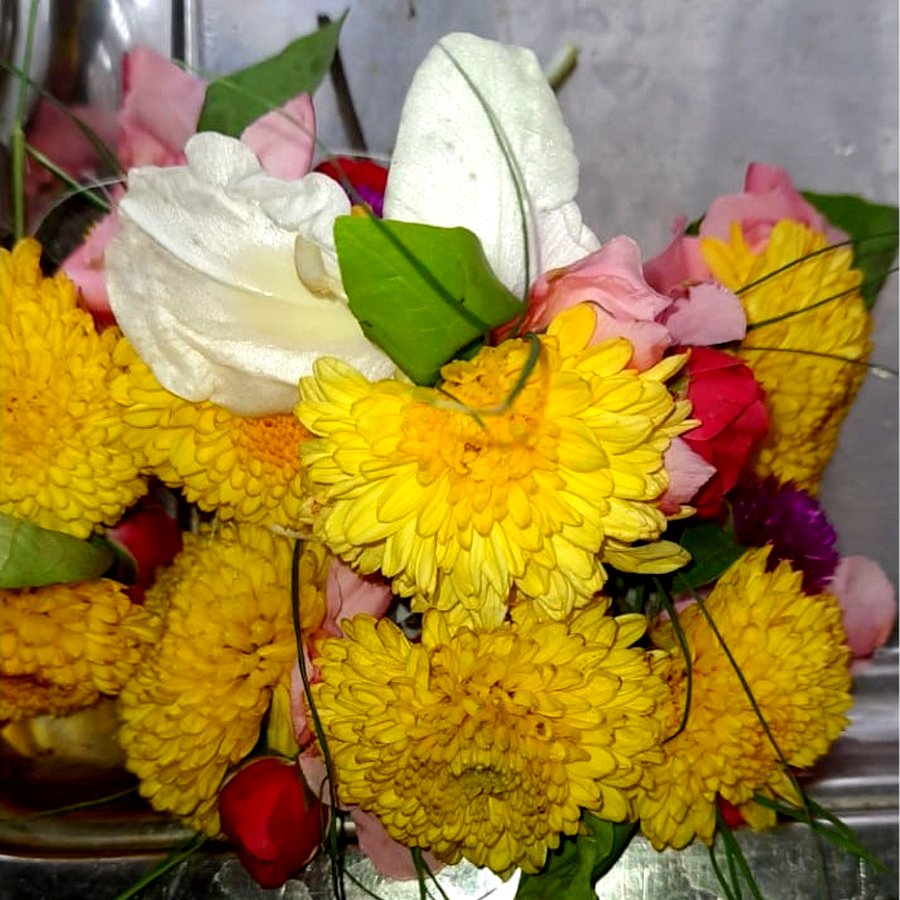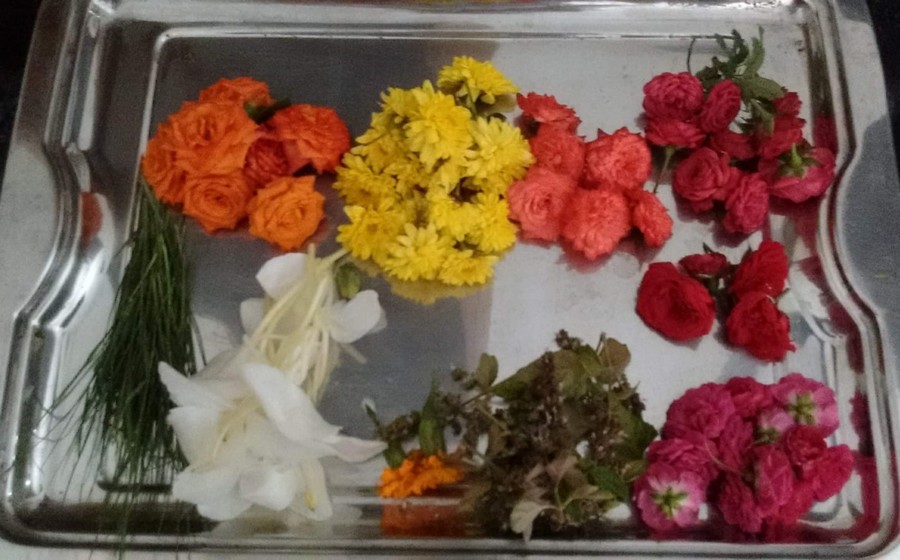Chūḍī Pūjā - A Unique Tradition
By Smt. Kushal Talgerī Bailūr with inputs and photos from Smt. Umā Savūr
The month of Shrāvaṇa brings with it a host of festivals. During this auspicious month, married women from the Chitrāpur Sāraswat Brāhmaṇa community perform “Chūḍī pūjā” on Fridays and Sundays for Saubhāgya - a long, happy married life.
Mythological significance
It is believed that Sītā offered this pūjā with wild grown flowers and plants/leaves during her Vanavāsa and hence, this pūjā came into existence. Another story says that the wild flowers had a strong desire to adorn the Devatā-s and Devī-s. The compassionate deities granted the wildflowers their wish by saying that during the month of Shrāvaṇa they could be tied together in a bunch (a Chūḍī) and after being sanctified through pūjā by married ladies, they may be offered to them.
How we Chitrāpur Sāraswat-s observe Chūḍī Pūjā
Married women of the family wake up early, have a head bath, dress up in traditional attire and prepare aesthetically designed Chūḍī-s by tying five blades of jirvāṅkura/durvā (a type of grass that has three blades at the tip) and five types of flowers. The number five is significant as it represents five married women in our Purāṇa-s and Itihāsa-s who are remembered even today for their devotion and commitment to the institution of marriage: Ahalyā, Mandodarī, Draupadī, Tārā and Sītā. They are considered role models for married women.
Traditionally, local and wild plants (‘Anvalī’, ‘Ghanta Maḍḍŏ’, ‘Nelanillī’ and ‘Pāchchakana’) and flowers (‘Ratnagandhī’- Peacock Flower, ‘Sugandhī’- Ginger Lily, ‘Shaṅkhapus͟hpa’-Butterfly Pea, ‘Karavīra’-Yellow Oleander and ‘Rathapus͟hpa’- Pagodā flower) are used. In cities where these are not easily available, durvā-s alo7ng with Gulāb (Rose), Shevantī (Chrysanthemum), Champā (Champak) and so on are used. Usually, the Chūḍī-s are made in odd numbers - 5, 9, 11, 15, 21. The offering of Chūḍī-s symbolize a token of our gratitude to God for the greenery and colourful flowers in bloom during the monsoon.
 Chudi
Chudi
Flowers and Durva
After the Tulasī pūjā, a raṅgolī is drawn outside the house. Haldī-kuṅkum is applied on either side of the threshold and one Chūḍī each is placed. The remaining steps are adorned with Chūḍī-s by the young, unmarried girls in the family. An ārati is done facing the house with a prayer asking Devī Laks͟hmī to bless the home with Sukha (happiness) and Shānti (peace). In many homes, the bhajana ‘Bhāgyadā Laks͟hmi Bārammā’ is sung. Next, Arghya is given to Sūrya Devatā (Sun God)- first aks͟hata (sanctified rice grains) are offered. Then water is poured from a kalasha while looking at the sun and the first shloka of the Navagraha stotram (Japākusuma Saṅkāsham…Divākaram) is chanted (Pg 147, Shrī Chitrāpur Stutimañjarī 2019 [Sanskrit])
Then, in the kitchen, the box used to store rice is decorated and haldī-kuṅkum and a Chūḍī is offered. Traditionally, in villages, the churner (khavlŏ) used to make butter is tied to a stick (khunṭŏ). A Chūḍī is tied to that stick. A Chūḍī is also offered to the water-well in the house.
On Sundays, on the reverse side of a clean, washed pāna [either betel leaf or plantain leaf], seven stones are kept. Each stone is smeared with haldī-kuṅkum and a Chūḍī is placed on it. This is done to show respect and receive blessings of the Ṛs͟hi patnī-s of the Saptaṛshi-s.
On the first Friday of Shrāvaṇa, one Chūḍī is kept for the Kula-Devī/Devatā (family deity) in the Dĕvākūḍa and one is given to the Ks͟hetra Devatā (local area deity) at the local temple. One Chūḍī is also offered to the ancestral married women who departed from this world before their husbands.
Finally, the elders in the house are given Chūḍī-s with pāna-vīḍŏ (betel leaves and arecanut) and their blessings are sought. The women also visit each other’s homes and distribute Chūḍī-s, a tradition that helped to strengthen family bonds and social relationships.
A newly married bride’s first Chūḍī pūjana is performed at her maternal home. Her mother accompanies her to the homes of relatives where she offers Chūḍī-s and receives gifts and blessings. In the second year of marriage, she performs the pūjā with her mother-in-law who then accompanies her to distribute Chūḍī-s to their relatives.
Chūḍī pūjā is a beautiful tradition that not only fosters social relationships but also helps strengthen marriages with the blessings of the Devatā-s and elders.



 Once the Chūḍī-s and Naivedya are ready, a raṅgolī is made in front of the Tulasī kaṭṭŏ. The Chūḍī-s are then placed on a phoḍī pāna (betel leaf) along with a phoḍī (arecanut) and Naivedya. Haldī-kuṅkum, flowers and aks͟hata (sanctified rice grains) are offered to Tulasī. The first Chūḍī is offered to Tulasī along with two phoḍī pāna and phoḍī and her blessings are sought.
Once the Chūḍī-s and Naivedya are ready, a raṅgolī is made in front of the Tulasī kaṭṭŏ. The Chūḍī-s are then placed on a phoḍī pāna (betel leaf) along with a phoḍī (arecanut) and Naivedya. Haldī-kuṅkum, flowers and aks͟hata (sanctified rice grains) are offered to Tulasī. The first Chūḍī is offered to Tulasī along with two phoḍī pāna and phoḍī and her blessings are sought.